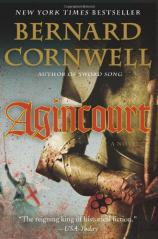Agincourt
Review
Agincourt
Here’s the situation. You’re a peasant, and as we
used to say back home, you’re so broke you can’t pay
attention. You’re in the middle of a medieval battlefield,
filled with rough characters and sharp weapons, with nothing to
cover your own precious hide but the clothes on your back. You have
one superb weapon --- the English longbow --- but not much in the
way of arrows. You also have a long, sharp stick, assuming you
haven’t burned it for firewood already. On the other side of
the line of battle, there is a nobleman, a feudal lord who owns,
more or less, the labor of hundreds of people just like you.
He’s on a horse, wearing a suit of armor that incorporates
all of the best technology of the day and worth more than your
entire village can produce in 10 years. You’ve shot your last
arrow, and the guy with the armor is coming to crush your skull. A
plan would seem to be in order.
This is what you do, if you’re lucky enough and strong
enough to pull it off. You plant yourself right in front of the
galloping, charging horse (nobody said this was going to be easy),
stab it with your sharpened stick, and hope that the animal is hurt
enough and scared enough to knock its rider clean off. While the
knight is still on his back, trapped under the weight of his armor,
you find the one weak spot in the armor --- his visor. And then you
draw your long hunting knife and stab the no-good wretch right in
the eye. Score one for the home team.
That’s the reality of medieval warfare. It’s savage,
messy, and a million miles away from something as comparatively
cold and dispassionate as pushing the button that unleashes
hundreds of pounds of high explosives from a Predator drone over a
terrorist camp. And if you want to bring back that world in
fiction, it’s not enough to reproduce the strategies of
battle and the blood and slaughter that follows in its wake. You
have to know the ground --- the sticky French mud that bogged down
a huge army, making it vulnerable to barefoot English archers. You
have to know the technology --- how the English craftsmen took a
piece of yew wood and shaped it into a weapon that changed history.
You have to know the dynastic politics that animate the strategy,
the engineering of the castles and the religious beliefs that led
men into battle.
In other words, it’s the kind of thing that Bernard
Cornwell has been doing for years --- and nobody does it
better.
If you’re not familiar with Cornwell’s work, you can
start with his bestselling novels about the Viking era in England,
which follow a ferocious war leader into the shield walls of Alfred
the Great. Or you can check out the monumental Richard Sharpe
series, which chronicles a Napoleonic War hero from the torture
pits of an Indian warlord all the way to a personal confrontation
with the Corsican corporal in exile on the lonely island of St.
Helena. Both of these series (as well as other Cornwell novels set
in the Civil War or the American Revolution) betray a comprehensive
knowledge of their respective historical eras --- and, even more
important, considerable skill in making the battlefields and
characters come to full, comprehensible life.
Cornwell’s books are populated with stout, resolute
heroes, noble enemies and the treacherous plots of evil men.
AGINCOURT is no exception; the differences are largely in the areas
of weapons technology, strategy and the intricate details of late
medieval life. Its principal hero, longbowman Nicholas Hook,
differs from most Cornwell protagonists in his religious faith
(notwithstanding that it’s hard to be a good Christian when
your job description involves stabbing people in the eye).
The story of the climactic battle of Agincourt has been told
before, most notably by Shakespeare, who gives King Henry perhaps
the most rousing speech in English literature. Cornwell
incorporates that speech in his narrative, but it’s more of a
grace note than anything else. The real work is done in the
trenches, by the men with the long bows and the empty stomachs.
Cornwell tells their story, and nobody does it better.
Reviewed by Curtis Edmonds, who writes on December 22, 2010
Agincourt
- Publication Date: January 1, 2010
- Genres: Fiction, Historical Fiction
- Paperback: 512 pages
- Publisher: Harper Paperbacks
- ISBN-10: 0061578908
- ISBN-13: 9780061578908





